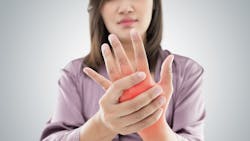You’ve heard of carpal tunnel. How about trigger finger?
Dental hygienists provide a wide variety of dental care to their patients each day to prevent and treat oral diseases, which is crucial to maintaining overall health. Helping our patients lead healthy lives and providing service to others are two of the primary goals of dental hygienists.
But what happens when our professional goals interfere with our personal health? Most of us are aware of the debilitating effects of carpel tunnel syndrome, but how many of you know about trigger finger?
The human hands are complex and delicate structures that each contain 27 bones. The muscles and joints in the hands allow for strong, precise, and dexterous movements, but they’re vulnerable to hand injury and pain, especially in our profession.1
The carpal tunnel is a narrow passageway surrounded by bones and ligaments on the palm side of the hand. Carpal tunnel syndrome is caused by pressure on the median nerve. When the median nerve is compressed, the symptoms include numbness, tingling, and weakness in the hand and arm.2 People such as dental hygienists, whose work requires repetitive gripping actions, are at high risk for developing carpal tunnel and/or trigger finger.
Related content:
Pain from dental hygiene: A nuisance, distressing, or debilitating?
Get the upper hand: Ergonomic strategies to avoid injuries
The connection between carpal tunnel and trigger finger
Trigger finger, or stenosing tenosynovitis, and carpal tunnel syndrome are two of the common conditions that hand surgeons treat. Studies suggest a significant concurrence rate between the two, but the implications of this have not been fully explored. Both disorders are important causes of occupational absenteeism and disability, and they often occur in the same hand.
Trigger finger happens when tendons—tough bands of tissue that connect muscles and bones in the finger and thumb—become irritated and inflamed.2 This inflammation interferes with the normal gliding motion of the tendon through the sheath. Each tendon is surrounded by a protective sheath. Your tendons run up your carpel tunnel to each finger. The pain usually begins at the base of each finger and is caused by swelling in the flexor tendons, which bend fingers into the palm.
If the tendon is too swollen, it can cause the finger to become stuck and be very painful when you try to straighten it. Trigger finger, which is more common in women, can occur after overuse, when the flexor tendons at the base of the hands enter a series of “pulleys,” or when tunnels and the swollen tendon get caught at the edge of the tunnel as the finger is bent and straightened. When the swollen tendon gets stuck on one side of the tunnel, a person often must force the finger straight, which is very painful.3
Trigger finger can affect any finger, including the thumb. More than one finger may be affected at a time, and both hands might be involved. Triggering is usually more pronounced in the morning, while grasping an object or straightening the finger. The affected finger typically begins to relax and move more easily as the day continues.3
The four stages of trigger finger:4
- There is tenderness at the base of the finger at the level of the first pulley (A1 pulley), or entrance to the tunnel.
- The finger has a catching sensation when flexing and extending it.
- The finger locks and needs to be manually straightened. This is usually associated with a painful pop.
- The finger may become fixed and locked in an extended position.
Signs and symptoms of trigger finger may progress from mild to severe and include:5
- finger stiffness, particularly in the morning,
- a popping or clicking sensation as the finger is moved,
- tenderness or a bump (nodule) in the palm at the base of the affected finger,
- finger catching or locking in a bent position, which then suddenly pops straight,
- and the finger locked in a bent position, which the person is unable to straighten.
How to treat trigger finger
How to treat trigger finger varies depending on its severity. It can generally correct itself after a short time. Taking nonsteroidal or anti-inflammatory drugs may help reduce pain. If pain becomes worse or won’t go away, then it’s time to visit a hand surgeon to be properly diagnosed. Often trigger finger can be treated successfully without surgery. The typical first line of treatment is generally a steroidal injection, which allows the tendon to glide more freely through the tunnel.3
At-home treatments include
- Taking a break from repetitive activities
- Applying heat or ice to reduce swelling
- Placing the hand in warm water several times a day to relax the tendons and muscles
- Gently stretching the fingers to enhance their range of motion3
Helpful exercises include finger extensor stretches, finger abduction, finger spread, palm presses, object pickups, the ‘O’ exercise, finger and hand openers, and massaging or rubbing in a gentle circular motion.5
You should start to see improvement within a few weeks to six months of consistent exercise. If you’ve done the exercises regularly and haven’t seen improvement, or if your symptoms get worse or are severe, you should see a doctor. Severe cases may become locked in the bent position and require surgery to correct.5
References
- Osborn CO. What’s causing my hand pain? Healthline. March 7, 2019. https://www.healthline.com/health/hand-pain
- El-Hadidi S. Is there a relation between carpal tunnel syndrome and trigger finger? 2015;(5)3:A65. doi:10.1186/1753-6561-9-S3-A65
- Trigger finger overview. Mayo Clinic. https://www.mayoclinic.org/diseases-conditions/trigger-finger/symptoms-causes/syc-20365100
- Nail R. Trigger finger. Healthline. May 10, 2019. https://www.healthline.com/health/trigger-finger#causes
- Cronkelton E. 11 Trigger finger exercises to try at home. Healthline. September 16, 2018. https://www.healthline.com/health/fitness-exercise/trigger-finger-exercises#finger-extensor-stretch
About the Author

Susan Clark, BS, RDH
Susan Clark, BS, RDH, is a key opinion leader, public speaker, and self-published author of Exploring Dental Hygiene, Finding the Hidden Rewards. She served two terms as president of the San Diego County Dental Hygienists' Society, and is a 2013 Sunstar/RDH Award of Distinction recipient. Susan has been the sole proprietor of a free dental clinic for 63 orphans at the Colina de Luz Christian Home for Children in La Gloria, Mexico for the past seven years. She is also an independent contractor on behalf of Waterpik, conducting presentations in Maricopa County, Arizona. Contact her at [email protected].
